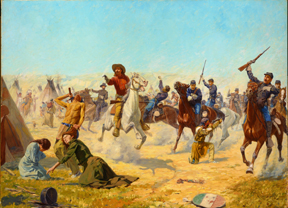The American Theme in Britain
By
INA COLE
ART
TIMES July, 2005
|
|
The
life and times of cultures removed from ones’ immediate
identity provides an endless source of fascination. How the ‘other’
lived and what they created as an imprint of their existence inevitably
becomes re-interpreted and embellished with time. Consequently, the history
of a place is viewed from the position of pre-conceived expectations,
arising from the way it has been packaged by the media and institutions,
but a number of exhibitions in Britain focusing on the theme of ‘America’,
attempt to dig beneath the surface culture to explore some of the hidden
truths that prevail. This summer, some of Britain’s most significant
museums have joined forces with their American counterparts in staging
exhibitions which highlight work never previously seen in Britain.
The first of these is at Compton Verney, Warwickshire comptonverney.org.uk (to 29 August).
The American West, explores how the identity of the West is bound up with different
myths arising from European expansion across North America. The exhibition
challenges notions of identity, freedom and politics to represent a contemporary
view of this complex subject, and offers the first opportunity for audiences
in Britain to view an extensive selection of work from an era that continues
to hold such global fascination. The American West presents historical and
contemporary work loaned exclusively from the United States, from institutions
including the National Cowboy and Western Heritage Museum, Oklahoma, the
Museum of the American West, Los Angeles, and the Buffalo Bill Historical
Centre, Cody, Wyoming.
Jimmie Durham, Curator of The American West, is an artist, writer and
activist of Cherokee descent. He planned the exhibition as a series of
visual stories, including poignant themes such as invasion and genocide;
the first official Indian wars; Native American encounter with white settlers
and the U.S. army; natural resources and environmental destruction, and
Hollywood and the cowboy. Included in the exhibition are historical depictions
of these subjects; nineteenth-century Plains Indian Ledger drawings; work
by Indian prisoners, and a large selection of works by contemporary Native
North American artists. The exhibition also contains a diverse selection
of historic ephemera from popular culture, including documentation of
Buffalo Bill’s Roadshow, photographs, dime novels, billboards and
film posters.
The American theme is continued in Printed States (to 30 October), an exhibition
at The American Museum in Britain, Bath, americanmuseum.org.uk which chronicles
the emergence of the popular print in America. This exhibition explores
America’s westward expansion and its growth in the nineteenth-century
from an agricultural society to an industrialised one. The story is told
through a wide range of images, including the Flathead Indians, the Shakers,
settlements of log cabins, the railways and airlines, George Washington,
the New York blaze of 1835, and the circus, in addition to works by J.M.
Whistler, one of America’s most influential nineteenth-century painters.
Printed States could not be shown in a more appropriate location, as The American Museum is unique in Britain, dedicated to the American way of life from colonial times to the mid- nineteenth century. Indigenous cultures are often presented in a relatively superficial way in order to be understood, but The American Museum is different in that history is presented through a series of authentically furnished rooms depicting the different styles in which the settlers lived, and focuses on the Shakers, New Mexicans, North American Indians and Pennsylvanian Germans. Each year the museum literally brings American history to life with vibrant demonstrations of Native American dancing, military drills, and enactments of the French and Indian War, and the American Civil War.
|
|
Impressionism Abroad offers a unique opportunity to view
a superb range of French and American paintings loaned to the Royal Academy
from Boston’s Museum of Fine Arts. During the nineteenth-century
many of Boston’s most celebrated artists were influenced by the
challenging movements in painting which developed in Europe at that time.
Some of these artists travelled to France and became directly influenced
by the Impressionist style, becoming amongst the earliest American’s
to embrace this innovative way of working. On return to the United States,
they adapted their style to create interpretations of local scenes, encouraging
acceptance of their work in America. Interestingly, the American painters,
unlike their French contemporaries, did become members of the art establishment,
which resulted in Boston’s development into one of the most forward-looking
centres of art at the time.
Crossing borders in a quest for the extraordinary became
the ultimate modern experience in the nineteenth-century. With rapid transfer
between countries and the increasing accessibility of a travel infrastructure,
the true social base became cosmopolitan, but with this came a consequent
rejection of tradition. However, there is now a current obsession with
the preservation of heritage and this is where museums play a big part,
as their displays are not just historicist, but nationalist in conception,
presenting the progress of civilisations through their artistic achievements.
The wealth of material in these three exhibitions alone offers an extraordinary
opportunity to learn more about the diverse cultures of America. Although
perceptions of actual events change with time, the quest to explore and
re-evaluate is more potent than ever, offering endless curatorial possibilities
in the staging of large-scale thematic exhibitions focusing on the history
of past cultures.

 Buffalo
Bill to the Rescue
Buffalo
Bill to the Rescue Schreyvogel
-The Summit Springs Rescue
Schreyvogel
-The Summit Springs Rescue